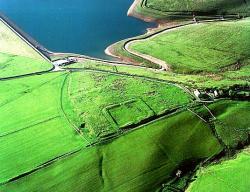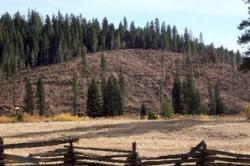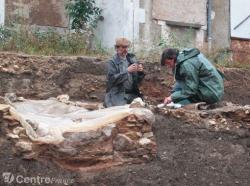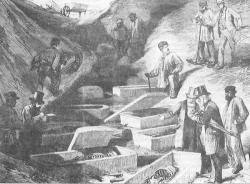INSTITUT SUPERIEUR D'ANTHROPOLOGIE
INSTITUTE OF ANTHROPOLOGY
ONLINE COURSES / COURS A DISTANCE
SUMMER SESSION : JULY 2013
REGISTER NOW
ROYAUME UNI –  Castleshaw - A dispute is brewing over the site of Castleshaw’s Roman fort and road after the Forestry Commission released proposals to plant 20 hectares of trees at Bleak Hey Nook Farm near Delph. The move has been met with fierce opposition from the Friends of Castleshaw Roman Fort and the Greater Manchester Archaeological Advisory Service. Both groups say the development would mean digging into the Roman Road and changing the character of the valley and site. The road - the main cross-Pennine highway linking fortresses at Chester and York - is one of the finest remaining Roman roads in Britain, widely believed to be of national historical significance. Norman Redhead, Heritage Management Director at GMAAS, said: “The Roman road remains may not be the only significant archaeology within the area; it’s just that it is visible.” He claims further research will reveal the full significance of the site: “Planting trees would compromise our ability to undertake future research, as well as damaging the archaeology of the road itself.”
Castleshaw - A dispute is brewing over the site of Castleshaw’s Roman fort and road after the Forestry Commission released proposals to plant 20 hectares of trees at Bleak Hey Nook Farm near Delph. The move has been met with fierce opposition from the Friends of Castleshaw Roman Fort and the Greater Manchester Archaeological Advisory Service. Both groups say the development would mean digging into the Roman Road and changing the character of the valley and site. The road - the main cross-Pennine highway linking fortresses at Chester and York - is one of the finest remaining Roman roads in Britain, widely believed to be of national historical significance. Norman Redhead, Heritage Management Director at GMAAS, said: “The Roman road remains may not be the only significant archaeology within the area; it’s just that it is visible.” He claims further research will reveal the full significance of the site: “Planting trees would compromise our ability to undertake future research, as well as damaging the archaeology of the road itself.”
http://www.oldham-chronicle.co.uk/news-features/8/news-headlines/80032/trees-row-takes-root-at-roman-site
ROYAUME UNI – Flodden - Another dig is to take place as part of the 500th anniversary of the Battle of Flodden. The second Flodden 1513 archaeology excavation will take place at Ladykirk in Berwickshire from May 4-14. The dig will investigate the fields between Ladykirk Church and the River Tweed and to the east of the church. The aim is to investigate features which were identified during geophysical surveys in last year. These include two possible gun placements on the edge of the river terrace, and the remains of an 18th Century farm steading to the east of the church. The steading, though later than the period of the battle, is being investigated with the aim of establishing whether there are earlier buildings possibly relating to Scottish King James IV's use of the site.
http://www.journallive.co.uk/north-east-news/todays-news/2013/05/01/volunteers-needed-for-flodden-dig-at-ladykirk-in-berwickshire-61634-33265444/
USA –  Humbug Valley - Recently discovered damage to American Indian archaeological sites has led to increased protections at a controversial logging project in Humbug Valley. Officials from Pacific Gas and Electric Co. and the California Department of Forestry and Fire Protection met at the site last week with Maidu Summit representatives following reports that PG&E logging equipment had broken a Maidu Indian grinding stone and compromised a prehistoric village site. Against the backdrop of a hillside virtually cleared of all timber, PG&E archaeologist James Nelson announced plans to suspend all logging activity until he and state officials can assess the damages and develop a new protection plan for the 368 logged acres in the valley 10 miles southwest of Lake Almanor. "We don't want to impact a cultural site. We're very concerned about that," Nelson said. A quick on-the-ground inspection of the area produced numerous obsidian chips and other American Indian artifacts, leading Nelson and Cal Fire officials to immediately expand a buffer area from less than an acre to around 3 acres. The timber harvest, started last fall under an emergency permit issued by Cal Fire, has already compromised an ancient trail and a village site more than 4,000 years old, said Beverly Benner Ogle, vice chairwoman of the Maidu Summit, a consortium of Maidu Indian tribal, nonprofit and grass-roots organizations.
Humbug Valley - Recently discovered damage to American Indian archaeological sites has led to increased protections at a controversial logging project in Humbug Valley. Officials from Pacific Gas and Electric Co. and the California Department of Forestry and Fire Protection met at the site last week with Maidu Summit representatives following reports that PG&E logging equipment had broken a Maidu Indian grinding stone and compromised a prehistoric village site. Against the backdrop of a hillside virtually cleared of all timber, PG&E archaeologist James Nelson announced plans to suspend all logging activity until he and state officials can assess the damages and develop a new protection plan for the 368 logged acres in the valley 10 miles southwest of Lake Almanor. "We don't want to impact a cultural site. We're very concerned about that," Nelson said. A quick on-the-ground inspection of the area produced numerous obsidian chips and other American Indian artifacts, leading Nelson and Cal Fire officials to immediately expand a buffer area from less than an acre to around 3 acres. The timber harvest, started last fall under an emergency permit issued by Cal Fire, has already compromised an ancient trail and a village site more than 4,000 years old, said Beverly Benner Ogle, vice chairwoman of the Maidu Summit, a consortium of Maidu Indian tribal, nonprofit and grass-roots organizations.
http://www.sacbee.com/2013/05/02/5388345/forestry-protections-increased.html
FRANCE –  Auxerre - «De l'époque gauloise jusqu'au XVIII e, voire au XIX e siècle, on a pu découvrir dans la ville des vestiges témoignant d'activités ou d'occupations, qui ne figurent pas dans les archives, et que seule l'archéologie peut mettre au jour », explique Fabrice Henrion, archéologue au Centre d'études médiévales d'Auxerre (CEM). Mais si, suite aux fouilles préventives exigées parfois par l'État avant de gros chantiers, « on commence à voir à peu près l'organisation de la ville médiévale, sa configuration antique est encore très mal connue », poursuit le scientifique.Ainsi, « nous ne pouvons encore déterminer si tel ou tel quartier était dédié à une activité particulière ». Car, poursuit Fabrice Henrion, « les travaux ne font pas toujours l'objet de fouilles préventives ». D'autant qu'il n'y a pas eu de grosses opérations de ce type « depuis les années quatre-vingt-dix », note-t-il. Précisément, au début de ces années-là, « on avait fait de grosses découvertes », relate Frédéric Devevey, archéologue à l'INRAP. « La plus grosse fouille qu'on a effectuée sur Auxerre concernait le quartier Vaulabelle », rappelle le spécialiste. Globalement, ces fouilles ont permis cependant de grosses découvertes. Sur place, les trouvailles d'alors témoignent « d'un habitat luxueux de l'époque romaine ». Aux Brichères, quartier excentré, des fouilles ont été également conduites en 2004,le diagnostic archéologique avait révélé « un site gallo-romain non stratifié ». Mais, selon le rapport des experts, « les structures identifiées relèvent à 90 % de la période médiévale et non de l'Antiquité ». Car, précise le document, « seule l'emprise située juste au nord de la fouille de 2004 a livré des structures attribuables au néolithique ». En 2010, place des Véens, au centre-ville, ont également été conduites des recherches. À cet endroit, « nous avons découvert plusieurs dizaines de sépultures datant du Moyen Âge, rappelle Fabrice Henrion. On pense qu'il s'agissait du cimetière de l'hôpital des comtes, qui était un de ceux qui existaient à Auxerre ». Aux abords de l'église Saint-Pierre, le secteur a fait aussi l'objet de recherches approfondies, en 2006-2007, les fouilles ont confirmé « l'appropriation de ce quartier dès l'Antiquité, même si les vestiges sont assez ténus ». Mais les spécialistes assurent qu'il s'agit bien d'une zone d'habitat occupée dès les I er et II e siècles. Cependant, nuancent les scientifiques : « L'étude du mobilier recueilli révèle une occupation au I er siècle de notre ère, sans que l'on en perçoive précisément l'organisation et la nature. » Bien des mystères demeurent donc encore concernant l'histoire d'Auxerre.
Auxerre - «De l'époque gauloise jusqu'au XVIII e, voire au XIX e siècle, on a pu découvrir dans la ville des vestiges témoignant d'activités ou d'occupations, qui ne figurent pas dans les archives, et que seule l'archéologie peut mettre au jour », explique Fabrice Henrion, archéologue au Centre d'études médiévales d'Auxerre (CEM). Mais si, suite aux fouilles préventives exigées parfois par l'État avant de gros chantiers, « on commence à voir à peu près l'organisation de la ville médiévale, sa configuration antique est encore très mal connue », poursuit le scientifique.Ainsi, « nous ne pouvons encore déterminer si tel ou tel quartier était dédié à une activité particulière ». Car, poursuit Fabrice Henrion, « les travaux ne font pas toujours l'objet de fouilles préventives ». D'autant qu'il n'y a pas eu de grosses opérations de ce type « depuis les années quatre-vingt-dix », note-t-il. Précisément, au début de ces années-là, « on avait fait de grosses découvertes », relate Frédéric Devevey, archéologue à l'INRAP. « La plus grosse fouille qu'on a effectuée sur Auxerre concernait le quartier Vaulabelle », rappelle le spécialiste. Globalement, ces fouilles ont permis cependant de grosses découvertes. Sur place, les trouvailles d'alors témoignent « d'un habitat luxueux de l'époque romaine ». Aux Brichères, quartier excentré, des fouilles ont été également conduites en 2004,le diagnostic archéologique avait révélé « un site gallo-romain non stratifié ». Mais, selon le rapport des experts, « les structures identifiées relèvent à 90 % de la période médiévale et non de l'Antiquité ». Car, précise le document, « seule l'emprise située juste au nord de la fouille de 2004 a livré des structures attribuables au néolithique ». En 2010, place des Véens, au centre-ville, ont également été conduites des recherches. À cet endroit, « nous avons découvert plusieurs dizaines de sépultures datant du Moyen Âge, rappelle Fabrice Henrion. On pense qu'il s'agissait du cimetière de l'hôpital des comtes, qui était un de ceux qui existaient à Auxerre ». Aux abords de l'église Saint-Pierre, le secteur a fait aussi l'objet de recherches approfondies, en 2006-2007, les fouilles ont confirmé « l'appropriation de ce quartier dès l'Antiquité, même si les vestiges sont assez ténus ». Mais les spécialistes assurent qu'il s'agit bien d'une zone d'habitat occupée dès les I er et II e siècles. Cependant, nuancent les scientifiques : « L'étude du mobilier recueilli révèle une occupation au I er siècle de notre ère, sans que l'on en perçoive précisément l'organisation et la nature. » Bien des mystères demeurent donc encore concernant l'histoire d'Auxerre.
http://www.lyonne.fr/yonne/actualite/pays/auxerrois/2013/05/02/la-vie-antique-de-la-ville-est-mal-connue-alors-que-son-organisation-medievale-lest-davantage-1536299.html
FRANCE –  Paris - Dès 1897, la Ville de Paris se dotait d’un service archéologique, qui connut un essor significatif à partir des années 1970-1980. Ce service, aujourd’hui appelé Département d’Histoire de l’Architecture et d’Archéologie de Paris (DHAAP), est agréé pour les fouilles en archéologie préventive depuis 2002. L’archéologie parisienne connaît ses premiers balbutiements dès l’époque médiévale, lorsque des découvertes de vestiges antiques, telles les « arènes » de Lutèce, sont signalées et interprétées de façon parfois fantaisistes. À l’époque moderne, les « antiquaires » proposent les premières interprétations raisonnées de vestiges archéologiques et après la Révolution française, les érudits multiplient les publications accompagnées d’illustrations de qualité. C’est cependant dans la deuxième moitié du XIXe siècle que naît véritablement l’archéologie parisienne, grâce à la personnalité étonnante de Théodore Vacquer (1824-1899). Architecte embauché en 1846 par l’administration parisienne pour exercer une surveillance archéologique des fouilles et démolitions, il parcourt inlassablement les chantiers de la capitale à l’époque des grands travaux haussmanniens qui ont radicalement transformé un Paris demeuré jusque-là médiéval. Il anime, entre 1853 et 1898, un premier service archéologique municipal officieux, créé près d’un siècle avant que ne soit promulguée une législation archéologique nationale. Les nombreuses observations qu’il réalise au cours de ses surveillances lui permettent de proposer la première restitution cohérente et significative du Paris antique et du haut Moyen Âge.
Paris - Dès 1897, la Ville de Paris se dotait d’un service archéologique, qui connut un essor significatif à partir des années 1970-1980. Ce service, aujourd’hui appelé Département d’Histoire de l’Architecture et d’Archéologie de Paris (DHAAP), est agréé pour les fouilles en archéologie préventive depuis 2002. L’archéologie parisienne connaît ses premiers balbutiements dès l’époque médiévale, lorsque des découvertes de vestiges antiques, telles les « arènes » de Lutèce, sont signalées et interprétées de façon parfois fantaisistes. À l’époque moderne, les « antiquaires » proposent les premières interprétations raisonnées de vestiges archéologiques et après la Révolution française, les érudits multiplient les publications accompagnées d’illustrations de qualité. C’est cependant dans la deuxième moitié du XIXe siècle que naît véritablement l’archéologie parisienne, grâce à la personnalité étonnante de Théodore Vacquer (1824-1899). Architecte embauché en 1846 par l’administration parisienne pour exercer une surveillance archéologique des fouilles et démolitions, il parcourt inlassablement les chantiers de la capitale à l’époque des grands travaux haussmanniens qui ont radicalement transformé un Paris demeuré jusque-là médiéval. Il anime, entre 1853 et 1898, un premier service archéologique municipal officieux, créé près d’un siècle avant que ne soit promulguée une législation archéologique nationale. Les nombreuses observations qu’il réalise au cours de ses surveillances lui permettent de proposer la première restitution cohérente et significative du Paris antique et du haut Moyen Âge.
http://bambou1980.canalblog.com/archives/2013/05/01/27057433.html